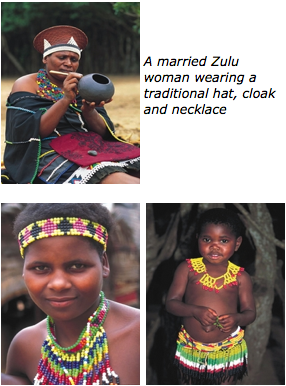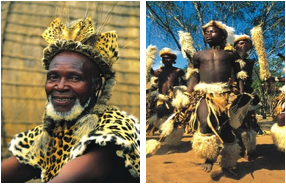 Zulu traditional dress
Zulu traditional dress
South Africa has a rich variety of cultures and traditions. To celebrate this, we have started a new series which will highlight a different culture in each issue of Vuk'uzenzele. The first of the series looks at traditional Zulu dress and its meaning.
Zulu women and girls
Traditional clothing is an important part of Zulu culture. It is colourful and bright and usually includes beautiful bead- work for women and children.
Married women have special status and wear different clothing to unmarried girls. Women who had a traditional Zulu wedding may wear a special wide hat called “isicholo” as a status symbol. “Ibhayi” is the cloak or shawl worn around the shoulders as a sign of respect to the in-laws. Married women also wear necklaces called “ureyisi” and cow-hide skirts called “isidwaba.”
Unmarried girls’ clothing include long strips of twisted beads called “izincu” around their ankles, elbows and waists. Young girls also wear short beaded skirts, colourful necklaces and beaded headbands. Children wear bead-work around their waists and necks.
- KwaZulu-Natal University
Zulu men
Zulu men traditionally wear a variety of clothing made from different animal hides. Like married women, married men also have special status. The front coverings for married men, for example, is called “umutsha” and differs from those worn by boys, which are smaller and called “iqoyi”. The back covering worn by men is called “ibheshu”.
 “Isicoco” is a head-ring worn by men and “imbhata” is a circular cowhide skin worn around a man’s neck. It used to be worn only by men who had killed another in battle. The shield worn with battle dress is called “ihawu”. Battle dress also include arm and ankle bands made of animal hide.
“Isicoco” is a head-ring worn by men and “imbhata” is a circular cowhide skin worn around a man’s neck. It used to be worn only by men who had killed another in battle. The shield worn with battle dress is called “ihawu”. Battle dress also include arm and ankle bands made of animal hide.
- KwaZulu-Natal University



 Facebook
Facebook Twitter
Twitter WhatsApp
WhatsApp